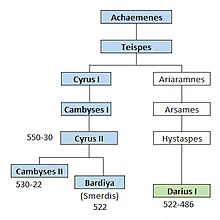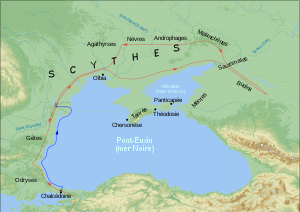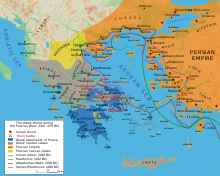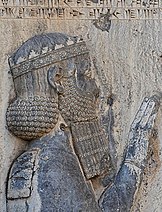Darius the Great
| Darius the Great 𐎭𐎠𐎼𐎹𐎺𐎢𐏁 | ||||||||||||||||||||||||||||||||||||||||||||||||||||||||||||||||||||||||||||||||||
|---|---|---|---|---|---|---|---|---|---|---|---|---|---|---|---|---|---|---|---|---|---|---|---|---|---|---|---|---|---|---|---|---|---|---|---|---|---|---|---|---|---|---|---|---|---|---|---|---|---|---|---|---|---|---|---|---|---|---|---|---|---|---|---|---|---|---|---|---|---|---|---|---|---|---|---|---|---|---|---|---|---|---|
| ||||||||||||||||||||||||||||||||||||||||||||||||||||||||||||||||||||||||||||||||||
| Reign | September 522 BCE – October 486 BCE | |||||||||||||||||||||||||||||||||||||||||||||||||||||||||||||||||||||||||||||||||
| Predecessor | Bardiya | |||||||||||||||||||||||||||||||||||||||||||||||||||||||||||||||||||||||||||||||||
| Successor | Xerxes I
| |||||||||||||||||||||||||||||||||||||||||||||||||||||||||||||||||||||||||||||||||
| Born | c. 550 BCE | |||||||||||||||||||||||||||||||||||||||||||||||||||||||||||||||||||||||||||||||||
| Died | October 486 BCE (aged approximately 64) | |||||||||||||||||||||||||||||||||||||||||||||||||||||||||||||||||||||||||||||||||
| Burial | ||||||||||||||||||||||||||||||||||||||||||||||||||||||||||||||||||||||||||||||||||
| Spouse | ||||||||||||||||||||||||||||||||||||||||||||||||||||||||||||||||||||||||||||||||||
| Issue |
| |||||||||||||||||||||||||||||||||||||||||||||||||||||||||||||||||||||||||||||||||
| ||||||||||||||||||||||||||||||||||||||||||||||||||||||||||||||||||||||||||||||||||
| Dynasty | Achaemenid | |||||||||||||||||||||||||||||||||||||||||||||||||||||||||||||||||||||||||||||||||
| Father | Hystaspes | |||||||||||||||||||||||||||||||||||||||||||||||||||||||||||||||||||||||||||||||||
| Mother | Rhodogune or Irdabama | |||||||||||||||||||||||||||||||||||||||||||||||||||||||||||||||||||||||||||||||||
| Religion | Indo-Iranian religion (possibly Zoroastrianism) | |||||||||||||||||||||||||||||||||||||||||||||||||||||||||||||||||||||||||||||||||
Darius I (
Darius ascended the throne by overthrowing the Achaemenid monarch
Darius organized the empire by dividing it into administrative provinces, each governed by a
Darius is mentioned in the books of Haggai, Zechariah, Daniel, and Ezra–Nehemiah of the Hebrew Bible (the Christian Old Testament).
Etymology
Dārīus and Dārēus are the
Primary sources
At some time between his
Darius the great king, king of kings, king of countries, son of Hystaspes, an Achaemenid. King Darius says: This is the kingdom which I hold, from the , the greatest of gods, bestowed upon me. May Ahuramazda protect me and my royal house!
— DPh inscription of Darius I in the foundations of the Apadana Palace
Early life
Darius was the eldest of five sons to Hystaspes.[8] The identity of his mother is uncertain. According to the modern historian Alireza Shapour Shahbazi (1994), Darius's mother was thought to have been a woman named Rhodogune.[8] However, according to Lloyd Llewellyn-Jones (2013), recently uncovered texts in Persepolis indicate that his mother was Irdabama, an affluent landowner descended from a family of local Elamite rulers.[15] Richard Stoneman likewise refers to Irdabama as the mother of Darius.[16] The Behistun Inscription of Darius states that his father was satrap of Bactria in 522 BCE.[a] According to Herodotus (III.139), Darius, prior to seizing power and "of no consequence at the time", had served as a spearman (doryphoros) in the Egyptian campaign (528–525 BCE) of Cambyses II, then the Persian Great King;[19] this is often interpreted to mean he was the king's personal spear-carrier, an important role. Hystaspes was an officer in Cyrus's army and a noble of his court.[20]
Before Cyrus and his army crossed the river
Accession

There are different accounts of the rise of Darius to the throne from both Darius himself and Greek historians. The oldest records report a convoluted sequence of events in which Cambyses II lost his mind, murdered his brother
Darius's account, written at the Behistun Inscription, states that Cambyses II killed his own brother Bardiya, but that this murder was not known among the
Herodotus provides a dubious account of Darius's ascension: Several days after Gaumata had been assassinated, Darius and the other six nobles discussed the fate of the empire. At first, the seven discussed the form of government: A democratic republic (Isonomia) was strongly pushed by Otanes, an oligarchy was pushed by Megabyzus, while Darius pushed for a monarchy. After stating that a republic would lead to corruption and internal fighting, while a monarchy would be led with a single-mindedness not possible in other governments, Darius was able to convince the other nobles.
To decide who would become the monarch, six of them decided on a test, with Otanes abstaining, as he had no interest in being king. They were to gather outside the palace, mounted on their horses at sunrise, and the man whose horse neighed first in recognition of the rising sun would become king. According to Herodotus, Darius had a slave, Oebares, who rubbed his hand over the genitals of a mare that Darius's horse favored. When the six gathered, Oebares placed his hands beside the nostrils of Darius's horse, who became excited at the scent and neighed. This was followed by lightning and thunder, leading the others to dismount and kneel before Darius in recognition of his apparent divine providence.[27] In this account, Darius himself claimed that he achieved the throne not through fraud, but cunning, even erecting a statue of himself mounted on his neighing horse with the inscription: "Darius, son of Hystaspes, obtained the sovereignty of Persia by the sagacity of his horse and the ingenious contrivance of Oebares, his groom."[28]
According to the accounts of Greek historians, Cambyses II had left
The details regarding Darius's rise to power is generally acknowledged as forgery and was in reality used as a concealment of his overthrow and murder of Cyrus's rightful successor, Bardiya.[29][30][31] To legitimize his rule, Darius had a common origin fabricated between himself and Cyrus by designating Achaemenes as the eponymous founder of their dynasty.[29] In reality, Darius was not from the same house as Cyrus and his forebears, the rulers of Anshan.[29][32]
Early reign
Early revolts

Following his coronation at
By 522 BCE, there were revolts against Darius in most parts of the
Elimination of Intaphernes
One of the significant events of Darius's early reign was the slaying of
The officers went to the king and showed him what Intaphernes had done to them. Darius began to fear for his own safety; he thought that all seven noblemen had banded together to rebel against him and that the attack against his officers was the first sign of revolt. He sent a messenger to each of the noblemen, asking them if they approved of Intaphernes's actions. They denied and disavowed any connection with Intaphernes's actions, stating that they stood by their decision to appoint Darius as King of Kings. Darius's choice to ask the noblemen indicates that he was not yet completely sure of his authority.[36]
Taking precautions against further resistance, Darius sent soldiers to seize Intaphernes, along with his son, family members, relatives and any friends who were capable of arming themselves. Darius believed that Intaphernes was planning a rebellion, but when he was brought to the court, there was no proof of any such plan. Nonetheless, Darius killed Intaphernes's entire family, excluding his wife's brother and son. She was asked to choose between her brother and son. She chose her brother to live. Her reasoning for doing so was that she could have another husband and another son, but she would always have but one brother. Darius was impressed by her response and spared both her brother's and her son's life.[37]
Military campaigns
Egyptian campaign
After securing his authority over the
Through another series of campaigns, Darius I would eventually reign over the territorial apex of the empire, when it stretched from parts of the
Invasion of the Indus Valley

In 516 BCE, Darius embarked on a campaign to Central Asia,
Babylonian revolt
After Bardiya was murdered, widespread revolts occurred throughout the empire, especially on the eastern side. Darius asserted his position as king by force, taking his armies throughout the empire, suppressing each revolt individually. The most notable of all these revolts was the Babylonian revolt which was led by Nebuchadnezzar III. This revolt occurred when Otanes withdrew much of the army from Babylon to aid Darius in suppressing other revolts. Darius felt that the Babylonian people had taken advantage of him and deceived him, which resulted in Darius gathering a large army and marching to Babylon. At Babylon, Darius was met with closed gates and a series of defences to keep him and his armies out.[41]
Darius encountered mockery and taunting from the rebels, including the famous saying "Oh yes, you will capture our city, when mules shall have foals." For a year and a half, Darius and his armies were unable to retake the city, though he attempted many tricks and strategies—even copying that which Cyrus the Great had employed when he captured Babylon. However, the situation changed in Darius's favour when, according to the story, a mule owned by Zopyrus, a high-ranking soldier, foaled. Following this, a plan was hatched for Zopyrus to pretend to be a deserter, enter the Babylonian camp, and gain the trust of the Babylonians. The plan was successful and Darius's army eventually surrounded the city and overcame the rebels.[42]
During this revolt, Scythian nomads took advantage of the disorder and chaos and invaded Persia. Darius first finished defeating the rebels in Elam, Assyria, and Babylon and then attacked the Scythian invaders. He pursued the invaders, who led him to a marsh; there he found no known enemies but an enigmatic Scythian tribe.[43]
European Scythian campaign

The
Darius crossed the
Despite the evading tactics of the Scythians, Darius's campaign was so far relatively successful.[48] As presented by Herodotus, the tactics used by the Scythians resulted in the loss of their best lands and of damage to their loyal allies.[48] This gave Darius the initiative.[48] As he moved eastwards in the cultivated lands of the Scythians in Eastern Europe proper, he remained resupplied by his fleet and lived to an extent off the land.[48] While moving eastwards in the European Scythian lands, he captured the large fortified city of the Budini, one of the allies of the Scythians, and burnt it.[48]
Darius eventually ordered a halt at the banks of Oarus, where he built "eight great forts, some eight miles [13 km] distant from each other", no doubt as a frontier defence.
Persian invasion of Greece

Darius's European expedition was a major event in his reign, which began with the invasion of
When
Darius responded by sending troops led by his son-in-law across the
Family
Darius was the son of Hystaspes and the grandson of
Death and succession

After becoming aware of the Persian defeat at the
Government
Organization

Early in his reign, Darius wanted to reorganize the structure of the empire and reform the system of taxation he inherited from Cyrus and Cambyses. To do this, Darius created twenty provinces called
The majority of the satraps were of
The imperial administration was coordinated by the chancery with headquarters at Persepolis, Susa, and Babylon with Bactria, Ecbatana, Sardis, Dascylium and Memphis having branches.[8] Darius kept Aramaic as the common language, which soon spread throughout the empire.[8] However, Darius gathered a group of scholars to create a separate language system only used for Persis and the Persians, which was called Aryan script and was only used for official inscriptions.[8] Before this, the accomplishments of the king were addressed in Persian solely through narration and hymns and through the "masters of memory".[62] Indeed, oral history continued to play an important role throughout the history of Iran.[62]
Economy
Darius introduced a new universal currency, the
The daric also improved government revenues as the introduction of the daric made it easier to collect new taxes on land, livestock and marketplaces. This led to the registration of land which was measured and then taxed. The increased government revenues helped maintain and improve existing infrastructure and helped fund
In an effort to further improve trade, Darius built canals, underground waterways and a powerful navy.[8] According to Herodotus, qanat irrigation technology was introduced to Egypt, which is supported by the historian Albert T. Olmstead.[65] He further improved and expanded the network of roads and way stations throughout the empire, so that there was a system of travel authorization for the King, satraps and other high officials, which entitled the traveller to draw provisions at daily stopping places.[66][8]
Religion
"By the grace of Ahuramazda am I king; Ahuramazda has granted me the kingdom."
— Darius, on the Behistun Inscription
While there is no general consensus in scholarship whether Darius and his predecessors had been influenced by Zoroastrianism,[67] it is well established that Darius was a firm believer in Ahura Mazda, whom he saw as the supreme deity.[67][68] However, Ahura Mazda was also worshipped by adherents of the (Indo-)Iranian religious tradition.[67][69] As can be seen at the Behistun Inscription, Darius believed that Ahura Mazda had appointed him to rule the Achaemenid Empire.[8]
Darius had dualistic philosophical convictions and believed that each rebellion in his kingdom was the work of druj, the enemy of Asha. Darius believed that because he lived righteously by Asha, Ahura Mazda supported him.[70] In many cuneiform inscriptions denoting his achievements, he presents himself as a devout believer, perhaps even convinced that he had a divine right to rule over the world.[71] However, his relationship with the deity was far more complex: in one inscription he writes "Ahura Mazda is mine, I am Ahura Mazda's"
In the lands that were conquered by his empire, Darius followed the same Achaemenid tolerance that Cyrus had shown and later Achaemenid kings would show.[8] He supported faiths and religions that were "alien" as long as the adherents were "submissive and peaceable", sometimes giving them grants from his treasury for their purposes.[8][72] He had funded the restoration of the Israelite temple which had originally been decreed by Cyrus, was supportive towards Greek cults which can be seen in his letter to Gadatas, and supported Elamite priests.[8] He had also observed Egyptian religious rites related to kingship and had built the temple for the Egyptian god, Amun.[8]
Building projects


During
Additionally, Darius sponsored large construction projects in Susa,
In Egypt, Darius built many temples and restored those that had previously been destroyed. Even though Darius was a believer of Ahura Mazda, he built temples dedicated to the Gods of the
-
Teheran)
-
Darius as Pharaoh of Egypt at the Temple of Hibis
-
Relief showing Darius I offering lettuces to the Egyptian deityAmun-Ra Kamutef, Temple of Hibis
See also
Notes
- Iranologist Pierre Briant states that this is an error.[17] Richard Stoneman likewise considers Herodotus's account to be incorrect.[18]
References
- ISBN 3-8053-2310-7, pp. 220–21.
- ^ "DĀḠESTĀN". Retrieved 29 December 2014.
- ISBN 978-0-253-20915-3. Retrieved 29 December 2014.
- ISBN 978-0-393-25093-0.
- ^ a b c Schmitt 1994, p. 40.
- ^ Duncker 1882, p. 192.
- ^ Egerton 1994, p. 6.
- ^ a b c d e f g h i j k l m n o p q r s t u v w x y z aa ab ac ad ae af ag ah ai aj ak Shahbazi 1994, pp. 41–50.
- ^ Kuhrt 2013, p. 197.
- ^ Frye 1984, p. 103.
- ^ Schmitt 1994, p. 53.
- JSTOR 43580364.
- ^ Persepolis : discovery and afterlife of a world wonder. 2012. pp. 171–181.
- ^ "Behistun, minor inscriptions - Livius". www.livius.org.
- ^ Llewellyn-Jones 2013, p. 112.
- ^ Stoneman 2015, p. 189.
- ^ Briant 2002, p. 467.
- ^ Stoneman 2015, p. 20.
- ^ Cook 1985, p. 217.
- ^ Abbott 2009, p. 14.
- ^ Abbott 2009, p. 14–15.
- ^ Abbott 2009, p. 15–16.
- ^ a b Boardman 1988, p. 54.
- ^ "cylinder seal | British Museum". The British Museum.
- ^ "Darius' seal, photo - Livius". www.livius.org.
- ^ "The Darius Seal". British Museum.
- ^ Poolos 2008, p. 17.
- ^ Abbott 2009, p. 98.
- ^ a b c Llewellyn-Jones 2017, p. 70.
- ^ Van De Mieroop 2003.
- ^ Allen, Lindsay (2005), The Persian Empire, London: The British Museum press, p. 42.
- ^ Waters 1996, pp. 11, 18.
- ^ Briant 2002, p. 115.
- ^ Briant 2002, pp. 115–116.
- ^ a b Briant 2002, p. 116.
- ^ a b c d e Briant 2002, p. 131.
- ^ Abbott 2009, p. 99–101.
- ^ Goodnick Westenholz, Joan (2002). "A Stone Jar with Inscriptions of Darius I in Four Languages" (PDF). ARTA: 2. Archived (PDF) from the original on 12 April 2018.
- ^ Qahéri, Sépideh. "Alabastres royaux d'époque achéménide". L’Antiquité à la BnF (in French).
- ^ Del Testa 2001, p. 47.
- ^ Abbott 2009, p. 129.
- ^ Sélincourt 2002, pp. 234–235.
- ^ Siliotti 2006, pp. 286–287.
- ^ Woolf et al. 2004, p. 686.
- ISBN 90-04-28215-7p. 70
- ^ Ross & Wells 2004, p. 291.
- ^ Beckwith 2009, pp. 68–69.
- ^ a b c d e f Boardman 1982, pp. 239–243.
- ^ Herodotus 2015, pp. 352.
- ^ Chaliand 2004, p. 16.
- ^ Grousset 1970, pp. 9–10.
- ^ ISBN 1-4443-5163-Xpp. 135–138, 343
- ISBN 978-1-4443-5163-7.
- ^ Briant 2002, p. 16.
- ^ Briant 2002, p. 113.
- ^ ISBN 978-0-500-20428-3.
- ^ Shahbazi 1988, pp. 514–522.
- ^ Briant 2002, p. 136.
- ^ Herodotus Book III, 89–95
- ISBN 978-0-19-958792-6.
- ^ "India Relations: Achaemenid Period – Encyclopaedia Iranica". iranicaonline.org.
- ^ a b Briant 2002, pp. 126–127.
- ^ Farrokh 2007, p. 65.
- ^ Farrokh 2007, pp. 65–66.
- ISBN 0-226-62777-2.
- ^ Konecky 2008, p. 86.
- ^ a b c Malandra 2005.
- ^ Briant 2002, p. 126.
- ^ Boyce 1984, pp. 684–687.
- ^ Boyce 1979, p. 55.
- ^ Boyce 1979, pp. 54–55.
- ^ Boyce 1979, p. 56.
- ^ Spielvogel 2009, p. 49.
- ^ Boardman 1988, p. 76.
- ^ Razmjou, Shahrokh (1954). Ars orientalis; the arts of Islam and the East. Freer Gallery of Art. pp. 81–101.
Bibliography
- Abbott, Jacob (2009), History of Darius the Great: Makers of History, Cosimo, Inc., ISBN 978-1-60520-835-0
- Abbott, Jacob (1850), History of Darius the Great, New York: Harper & Bros
- Balentine, Samuel (1999), The Torah's vision of worship, Minneapolis: Fortress Press, ISBN 978-0-8006-3155-0
- Beckwith, Christopher (2009), Empires of the Silk Road: a history of Central Eurasia from the Bronze Age to the present (illustrated ed.), Princeton University Press, ISBN 978-0-691-13589-2
- Bedford, Peter (2001), Temple restoration in early Achaemenid Judah (illustrated ed.), Leiden: Brill, ISBN 978-90-04-11509-5
- Bennett, Deb (1998), Conquerors: The Roots of New World horsemanship, Solvang, CA: Amigo Publications, Inc., ISBN 978-0-9658533-0-9
- Boardman, John (1988), The Cambridge Ancient History, vol. IV (II ed.), Cambridge: Cambridge University Press, ISBN 978-0-521-22804-6
- Boardman, John, ed. (1982). ISBN 978-0-521-22804-6.
- ISBN 978-0-415-23902-8.
- Boyce, M. (1984). "Ahura Mazdā". Encyclopaedia Iranica, Vol. I, Fasc. 7. pp. 684–687.
- Briant, Pierre (2002). From Cyrus to Alexander: A History of the Persian Empire. Eisenbrauns. pp. 1–1196. ISBN 978-1-57506-120-7.
- Chaliand, Gérard (2004), Nomadic empires: from Mongolia to the Danube (illustrated, annotated ed.), Transaction Publishers, ISBN 978-0-7658-0204-0
- Cook, J. M. (1985), "The Rise of the Achaemenids and Establishment of their Empire", The Median and Achaemenian Periods, Cambridge History of Iran, vol. 2, London: Cambridge University Press
- Del Testa, David (2001), Government leaders, military rulers, and political activists (illustrated ed.), Greenwood Publishing Group, ISBN 978-1-57356-153-2
- Duncker, Max (1882), Evelyn Abbott (ed.), The history of antiquity (Volume 6 ed.), R. Bentley & son
- Egerton, George (1994), Political memoir: essays on the politics of memory, Routledge, ISBN 978-0-7146-3471-5
- ISBN 978-3-406-09397-5.
- Farrokh, Kaveh (2007), Shadows in the desert: ancient Persia at war, Osprey Publishing, ]
- Grousset, René (1970). The Empire of the Steppes: A History of Central Asia. Rutgers University Press. pp. 1–687. ISBN 978-0-8135-1304-1.
- ISBN 978-0-375-71271-5.
- Konecky, Sean (2008), Gidley, Chuck (ed.), The Chronicle of World History, Old Saybrook, CT: Grange Books, ISBN 978-1-56852-680-5
- Kuhrt, A. (2013). The Persian Empire: A Corpus of Sources from the Achaemenid Period. Routledge. ISBN 978-1-136-01694-3.
- ISBN 978-0-7486-7711-5.
- Llewellyn-Jones, Lloyd (2017). "The Achaemenid Empire". In Daryaee, Touraj (ed.). King of the Seven Climes: A History of the Ancient Iranian World (3000 BCE - 651 CE). UCI Jordan Center for Persian Studies. pp. 1–236. ISBN 978-0-692-86440-1.
- Malandra, William W. (2005). "Zoroastrianism i. Historical review up to the Arab conquest". Encyclopaedia Iranica.
- Moulton, James (2005), Early Zoroastrianism, Kessinger Publishing, ]
- Poolos, J (2008), Darius the Great (illustrated ed.), Infobase Publishing, ISBN 978-0-7910-9633-8
- Ross, William; Wells, H. G. (2004), The Outline of History: Volume 1 (Barnes & Noble Library of Essential Reading): Prehistory to the Roman Republic (illustrated ed.), Barnes & Noble Publishing, ISBN 978-0-7607-5866-3, retrieved 28 July 2011
- Safra, Jacob (2002), The New Encyclopædia Britannica, Encyclopædia Britannica Inc, ISBN 978-0-85229-787-2
- Schmitt, Rudiger (1994). "DARIUS i. The Name". Encyclopaedia Iranica, Vol. VII, Fasc. 1. p. 40.
- Sélincourt, Aubrey (2002), The Histories, London: Penguin Classics, ISBN 978-0-14-044908-2
- Shahbazi, A. Shapur (1988). "Bahrām II". Encyclopaedia Iranica, Vol. III, Fasc. 5. pp. 514–522.
- Shahbazi, Shapur (1994), "Darius I the Great", Encyclopedia Iranica, vol. 7, New York: Columbia University, pp. 41–50
- Siliotti, Alberto (2006), Hidden Treasures of Antiquity, Vercelli, Italy: VMB Publishers, ISBN 978-88-540-0497-9
- Spielvogel, Jackson (2009), Western Civilization: Seventh edition, Belmont, CA: Thomson Wadsworth, ISBN 978-0-495-50285-2
- Stoneman, Richard (2015). Xerxes: A Persian Life. ISBN 978-1-57506-120-7.
- Tropea, Judith (2006), Classic Biblical Baby Names: Timeless Names for Modern Parents, New York: Bantam Books, ISBN 978-0-553-38393-5
- Van De Mieroop, Marc (2003), A History of the Ancient Near East: Ca. 3000–323 BC, "Blackwell History of the Ancient World" series, Hoboken, NJ: ISBN 978-0-631-22552-2
- Waters, Matt (1996). "Darius and the Achaemenid Line". The Ancient History Bulletin. 10 (1). London: 11–18.
- Waters, Matt (2014). Ancient Persia: A Concise History of the Achaemenid Empire, 550–330 BCE. Cambridge University Press. pp. 1–272. ISBN 978-1-107-65272-9.
- Woolf, Alex; Maddocks, Steven; Balkwill, Richard; McCarthy, Thomas (2004), Exploring Ancient Civilizations (illustrated ed.), Marshall Cavendish, ISBN 978-0-7614-7456-2
Further reading
- Burn, A.R. (1984). Persia and the Greeks : the defence of the West, c. 546–478 B.C (2nd ed.). Stanford, CA: ISBN 978-0-8047-1235-4.
- Ghirshman, Roman (1964). The Arts of Ancient Iran from Its Origins to the Time of Alexander the Great. New York: Golden Press.
- Hyland, John O. (2014). "The Casualty Figures in Darius' Bisitun Inscription". Journal of Ancient Near Eastern History. 1 (2): 173–199. S2CID 180763595.
- Klotz, David (2015). "Darius I and the Sabaeans: Ancient Partners in Red Sea Navigation". Journal of Near Eastern Studies. 74 (2): 267–280. S2CID 163013181.
- Olmstead, Albert T. (1948). History of the Persian Empire, Achaemenid Period. Chicago: University of Chicago Press.
- Vogelsang, W.J. (1992). The rise and organisation of the Achaemenid Empire : the eastern Iranian evidence. Leiden: Brill. ISBN 978-90-04-09682-0.
- Warner, Arthur G. (1905). The Shahnama of Firdausi. London: Kegan Paul, Trench, Trübner and Co.
- Wiesehöfer, Josef (1996). Ancient Persia : from 550 BC to 650 AD. Azizeh Azodi, trans. London: I.B. Tauris. ISBN 978-1-85043-999-8.
- Wilber, Donald N. (1989). Persepolis : the archaeology of Parsa, seat of the Persian kings (Rev. ed.). Princeton, NJ: Darwin Press. ISBN 978-0-87850-062-8.
External links









![Egyptian statue of Darius I, as Pharaoh of the Twenty-seventh Dynasty of Egypt;[75] 522–486 BCE; greywacke; height: 2.46 m;[56] National Museum of Iran (Teheran)](http://upload.wikimedia.org/wikipedia/commons/thumb/6/6f/National_Meusem_Darafsh_6_%2842%29.JPG/132px-National_Meusem_Darafsh_6_%2842%29.JPG)


